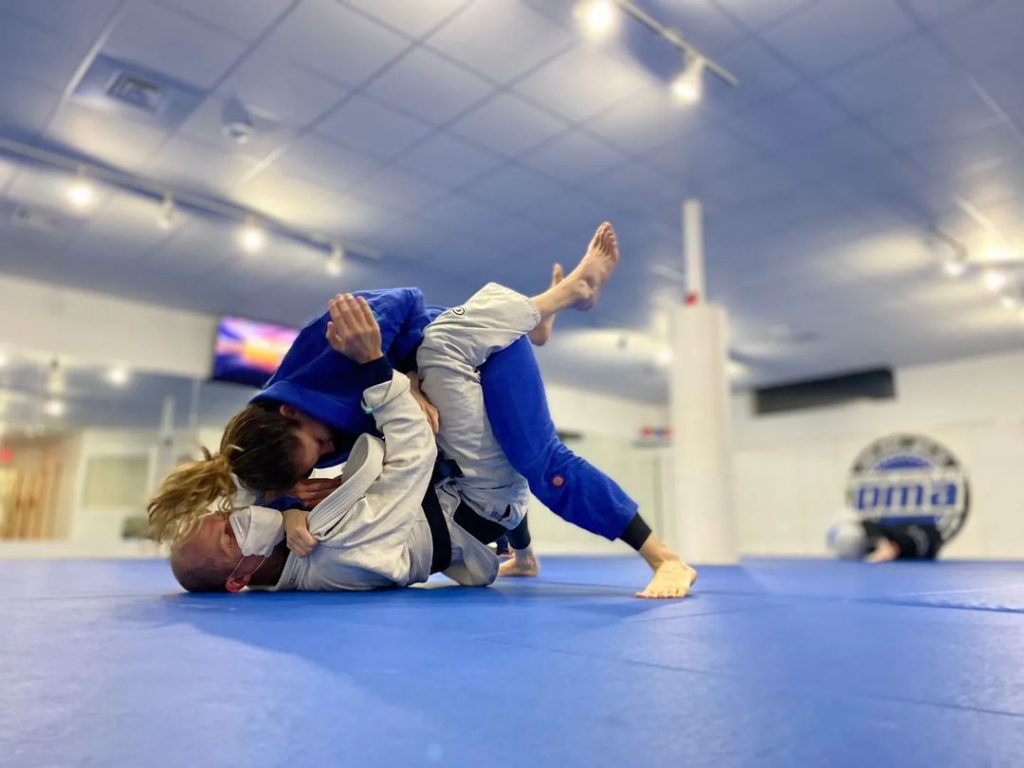
The overall strategy for a Brazilian Jiu Jitsu practitioner in a combat situation is to:
(Many times, step 1 is the moment an aggressor grabs YOU in a self-defense situation.)
Brazilian Jiu Jitsu is an adaption of Judo by brothers, Carlos and younger brother, Helio Gracie, that occurred in Brazil in the early to mid 1900’s.
Helio found that he was unable to force his will on resisting opponents, since he was smaller. As a result, he spent his life fine-tuning those techniques to further maximize leverage, and neutralize any size disadvantage, in combat. This led to their renaming of the evolving art to Gracie Jiu Jitsu.
Both Carlos and Helio had very large families, with many sons who continued to pursue the art, creating the largest family dynasty in any sport in modern history. Today many use the term Brazilian Jiu Jitsu, since instructors are not only Gracies anymore. (At PMA, we proudly teach and use the term Gracie Jiu Jitsu).
The art is best known for its focus on ground techniques, which developed out of Kodokan Judo’s newaza, or ground fighting.
Brazilian Jiu Jitsu saw its greatest surge in popularity in the 90’s when Pay-Per-View, and art-vs-art Ultimate Fighting Championship was won repeatedly by a not-especially-large-or-athletic “regular guy” Royce Gracie (son of Grandmaster Helio). Some of these fights were David vs Goliath matches, and many spectators were stunned to see size and strength neutralized so effectively by Royce’s technique. Royce left the cage from most matches without taking damage, and in many of these no-hold-barred fights, Royce walked out without a single strike having landed on him.
The same was happening with brother, and renowned champion of the family (and more athletic appearing) Rickson Gracie in Japan in the Pride matches of the same era. Rickson is known to be undefeated, and is generally regarded as the best living jiu jitsu practitioner ever, and a legend.
Pedro Sauer was a best friend of Rickson Gracie, and began training at 15 years old with Helio Gracie. The same size as Helio, he became a favorite training partner of Helio’s, and received his advancements, including his black belt from Helio and Rickson. Pedro Sauer was Royce Gracie’s trainer for UFC 1 in 1993, and had numerous art-vs-art challenge matches of his own in “the early days.” He was recently voted by an online poll as the “Best Brazilian Jiu Jitsu Instructor” in the world.
Since the 90’s, the resulting influx of practitioners has created a number of international networks of schools. The best advice for students seeking to learn the complete art of Brazilian Jiu Jitsu is to seek instruction from someone with a known and respected lineage of fluent teachers. For many, the shorthand for this advice is, “train as close to the source as possible.” At PMA, the lineage of owner, Greg Wood is:
Helio Gracie > Rickson Gracie > Pedro Sauer > Greg Wood
Greg is among the first generation of American students to learn directly from the Gracies. Prior to his time as a student of Pedro Sauer, Greg studied directly under Royce Gracie from 1997 until 2013.
Brazilian Jiu Jitsu has enjoyed a greatly increased interest in its sportive side in the last decade. In the sport, two jiu jitsu practitioners compete to defeat pre-arranged opponents within their weight class, with either a submission, points gained from acquisition of position, or advantages gained in submission attempts. There is no striking, only grappling. While BJJ is a thrilling sport, the sport is not in itself a complete representation of Brazilian Jiu Jitsu, the martial art.
As with all martial arts, Jiu Jitsu was created for survival and escape from or defeat of an aggressor. The difference is, in a street self-defense scenario, the perpetrator could be any size, appear with no notice, be high on drugs with no sense of pain, will of course be throwing strikes and following no rule set, and the assault could take place in any venue (no lights, confined space, obstacles, other attackers or dangers).
With this in mind, our objective in teaching the martial art is to prepare for a realistic situation in which a person may have to defend their life in hand to hand combat, as opposed to solely in sport competition.
Brazilian Jiu Jitsu is known for its efficacy in those situations in which a fight goes to the ground. This reputation was rightly earned when Royce Gracie was the multiple-time victor in the art-vs-art Ultimate Fighting Championship in the 90’s. Representing Gracie Jiu Jitsu against other fighting styles, Royce repeatedly took his opponents to the ground and finished them there.
Until then, martial arts practitioners had mostly talked about how to get faster punches or higher kicks. Overnight, the martial arts world switched its focus to “groundwork,” to fill what had been a void.
Because of this history, there are many who had martial arts backgrounds who saw Brazilian Jiu Jitsu was a good “secondary tool” for them. There are martial arts practitioners from this era who even attained black belts in jiu jitsu to “fill their deficiency,” and still see BJJ as merely a supplement.
To Royce, the other champions in the Gracie family, and other Jiu Jitsu purists, Jiu Jitsu was always a complete martial art, which taught strategy, strikes, throws, AND what to do on the ground. This vision of Brazilian Jiu Jitsu as a complete martial art, sufficient to handle all hand-to-hand scenarios is the one we at PMA teach and espouse.
While the description of chokes and joint breaks may sound violent, jiu jitsu is japanese for the “gentle art.” Brazilian Jiu Jitsu seeks primarily to make connection with and gain control over the opponent. Control through connection helps smother strikes, and control an opponent, even “peacefully.”
Still, martial arts are meant to teach how to succeed when an aggressor tries to control or hurt you, so there will always be violence in that conversation, and should be. Brazilian Jiu Jitsu is the right choice in response to that violence for those who do not wish to rely on force (their athleticism) or accuracy of strikes in a chaotic situation.
The aggressor who succumbs to a choke by the jiu jitsu practitioner simply wakes up a few moments later, dazed.
When two practitioners of Jiu Jitsu spar against one another, they can practice all of their grappling techniques, using nearly 100% effort against nearly 100% resistance – every day, if they like. This “hands-on” practice ensures that both partners get to practice their offense and defense in rapidly changing, even chaotic scenarios. This guarantees a comparatively greater level of realism than striking heavy bags or shadow enemies, and is more like a real assault situation than it would be, even, to work with predictable, fully cooperative practice partners.
(Sparring is not something students are allowed to partake in at PMA until granted permission, based on experience level, by their instructor)
While many martial arts may depend on being stronger or faster than ones opponent, jiu jitsu very intentionally does not. This art is known for its small-but-successful forefathers in no-holds-barred fights (see Mitsuyo Maeda, Helio Gracie, Royce Gracie). These practitioners are a part of YOUR direct lineage, as a student at Plainville Martial Arts. Being big enough, fit enough, young enough, or even coordinated enough is a non-issue. The jiu jitsu answers to the problems of combat are always simple and doable by anybody.
We believe in leverage, technique, and fighting smarter, not harder. On your first successful execution of a technique, you will see what we mean!
Plainville
Forestville
Bristol
Plantsville
Farmington
Southington
New Britain
Berlin
Newington
Wolcott
Plantsville
Rocky Hill
Avon
West Hartford
Thomaston
Waterbury
Meriden
Burlington
